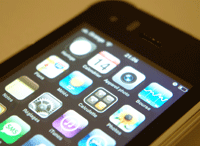 More and more smartphone applications (or “apps”) are being used as tools in health care. Consumers are using health care apps to monitor their intake for healthy weight management, while physicians have apps to view patients’ X-rays on their mobile communications devices. Indeed, 500 million smartphone users will use a health care application by 2015, according to a 2010 market research
report by Research2Guidance.
More and more smartphone applications (or “apps”) are being used as tools in health care. Consumers are using health care apps to monitor their intake for healthy weight management, while physicians have apps to view patients’ X-rays on their mobile communications devices. Indeed, 500 million smartphone users will use a health care application by 2015, according to a 2010 market research
report by Research2Guidance.
Optometrist Barry Eiden, medical director for North Suburban Vision Consultants in Illinois, is using these tiny tablets in his examination rooms. In the past, he would have to go into his back office and do calculations for hours, which slowed things down. Now his patients—especially the older ones—are amazed at the technology used in his office, he says.
“Their eyes light up,” Dr. Eiden says. “They think back to when they got eye exams as kids, which basically was a doctor pulling out lenses from a drawer asking, ‘Which is better, one or two?’ Nowadays, everything is done via computer.”
The FDA has publicly stated it encourages the exciting development of new applications that can make health care better. On the other side of the coin, the FDA also says it has a public health responsibility to oversee the safety and effectiveness of those mobile medical applications, which present a potential risk to patients if they don’t work as intended.
Dr. Eiden says he only uses mobile apps for reference or for patient education. He does not use apps for testing patients, out of concern for their accuracy.
“I am a little leery about [using testing apps], and I would certainly want to make sure that the tests are valid in terms of their medical validity,” Dr. Eiden says.
Peper Long, the FDA’s associate director for external communications for the Center for Devices, says the government is taking action now before reported problems start popping up.
“At this time we haven’t received any reports of problems related specifically to mobile medical applications,” Ms. Long says. “We do usually expect under-reporting in devices in general. And perhaps … we may see an increase in the number of reports with this increased awareness in the guidance.”
The FDA has released a proposal for regulating mobile medical applications, and is seeking input on its proposed oversight approach for certain mobile medical apps. The FDA says it’s focusing only on a select group of applications, and will not regulate the sale or general consumer use of smartphone or tablets.
“The FDA has defined a small subset of mobile and medical applications that may impact performance or functionality of currently regulated medical devices,” says Bakul Patel, policy advisor from the FDA’s Center for Devices.
Types of Apps to Be Regulated
The FDA’s definition includes mobile medical applications that are used as an accessory to a medical device that is already regulated by the FDA. One example of this is an application that allows a health care professional to make a specific diagnosis by viewing a medical image from a picture archiving and communication system, also known as PACS, on a smartphone or mobile tablet.
The definition will also include a mobile medical application that can transform a mobile communication device into a regulated medical device by using attachments or sensors. One example is an application that turns a smartphone into an ECG machine or into an electronic stethoscope to detect abnormal heart rhythms or determine if the patient’s experiencing a heart attack.
“We believe this outline approach… will continue to promote innovation in this new and expanding field,” Mr. Patel says.
How You Can Help
The FDA is encouraging feedback from manufacturers, health care providers and other stakeholders in how this proposal will support the balance between promoting innovation and ensuring safety and effectiveness. To that end, you can submit an electronic comment to
www.regulations.gov. Hurry, because the deadline for comment is October 19 (although the FDA may continue to accept comments after that date).
The Future
At this time the FDA does not have an enforcement plan for approaching an app manufacturer if the app does not work up to par. “I think we will be able to look at it on a case-by-case basis, and we would enforce as it’s appropriate. I don’t think a blanket statement would work in any particular situation, including currently-regulated medical devices,” Mr. Patel says.
In meantime, Dr. Eiden says he will continue using educational apps in his practice as well as recommending his patients to use certain apps to learn more about their conditions.
Mr. Sacopulos is a partner with Sacopulos, Johnson & Sacopulos, in Terre Haute, Ind. His core expertise is in medical malpractice defense and third party payment disputes. He can be reached at mike_sacopulos@sacopulos.com.

